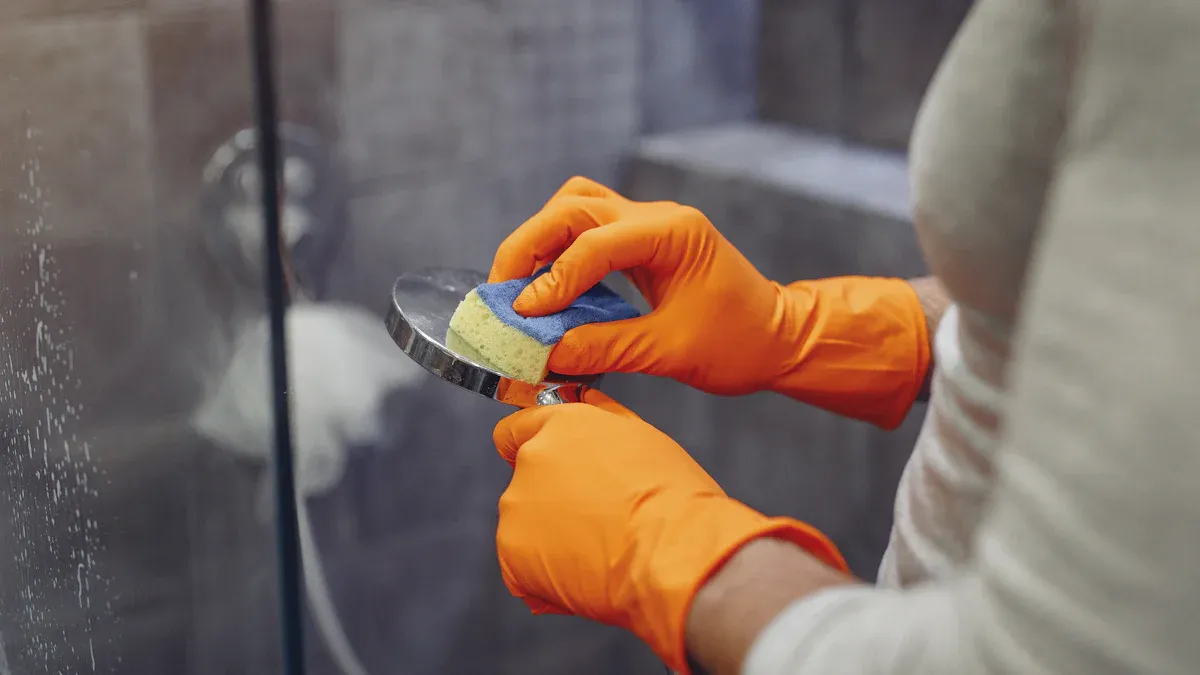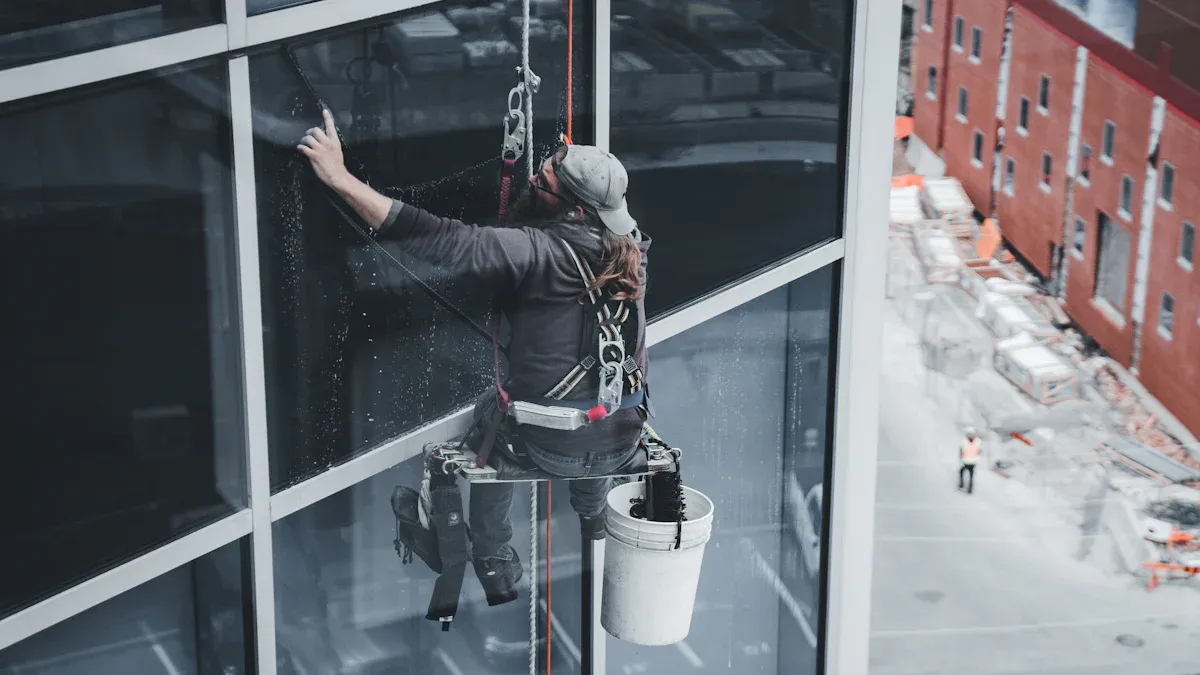
31 Aug A Complete Guide to Sealing ACP Curtain Wall Joints
You get the best results when you seal ACP curtain wall joints using effective sealing techniques and strong silicone sealants. Proper sealing techniques keep air and water out, protecting the building from harsh weather while helping to save energy.
Stopping thermal bridging and air leaks with the right sealing techniques keeps heat inside, saving both energy and money.
Waterproof barriers and strong gaskets, applied with precise sealing techniques, maintain insulation effectiveness by preventing condensation and reducing mold and rust risks.
Careful surface cleaning and allowing for movement are essential sealing techniques that help the seal last longer.
Key Takeaways
Clean ACP curtain wall joints well before sealing. This helps the sealant stick better and last longer.
Use neutral cure, low modulus silicone or hybrid MS Polymer sealants. These make joints strong, flexible, and weatherproof.
Put sealant on when the weather and temperature are right. Follow steps like masking edges and smoothing the sealant for good results.
Check sealed joints often, at least two times each year. Fix cracks or gaps fast to stop leaks and damage.
Take care of joints by cleaning and tightening fasteners. Repair damaged sealant to keep the building energy-efficient and safe.
Preparation
Cleaning
Start by cleaning before sealing ACP curtain wall joints. Clean surfaces help sealant stick well and last longer. Use mild soap or detergent with warm water. Soft brushes or gentle cloths work best for scrubbing panels. Do not use harsh chemicals or rough cleaners. Avoid scouring pads because they can harm the protective coating. High-pressure washers can push water into joints and cause trouble.
Follow these steps for good cleaning:
Clean the sealing area slowly. Keep cleaning solution inside the joint area.
Change cleaning gauze often to keep cleaning strong.
After cleaning, wipe the area with dry, clean gauze to remove leftover solvent.
Make sure the sealing surface is dry before you put on sealant.
Tip: Pay close attention to corners and joint edges. Dirt and debris gather in these spots and can cause leaks.
Priming
Check ACP panels and joints before priming. Lay out panels by the design and measure carefully to keep things straight. Use sharp cutting tools for neat edges. Secure panels with fasteners spaced evenly. After putting panels in, look for gaps or mistakes. Fix problems or touch up spots to make it look good and work well.
Look at the substrate for cracks, gaps, or rough spots. Make sure panels line up and have even spacing. Clean joint areas to get rid of dirt. Check that mounting systems and fasteners are tight. Focus on weak spots like corners and joints. Smooth joints help sealant stick better.
Note: Always pick sealants that bend and last, like silicone or polyurethane, for strong protection.
Good cleaning and checking help sealing work well. You make a surface that lets sealant bond and do its job.
Sealing Techniques

Silicone Sealants
Picking the right sealant for ACP curtain wall joints is important. It helps keep the building safe and the seal lasts a long time. Neutral cure, low modulus silicone sealants are best for this job. Some products, like the SilPruf™ series, are made for curtain wall joints. These sealants make a strong silicone rubber barrier. This barrier stops mold, mildew, air, and water from getting in. They also handle bad weather and keep joints looking nice.
Neutral silicone sealants, like Neutral Silicone Transparent Sealant 6187 and Neutral Silicone Structural Adhesive 6152, stick well and fight weather damage. You can use them inside or outside when installing ACP sheets. They do not break down in sunlight or heat. This helps the joints stay strong even when the weather is tough.
Hybrid technology sealants, such as MS Polymer sealants, are another choice for sealing techniques. These sealants dry into a hard, rubbery plastic. They stick together better than regular silicone sealants. Hybrid sealants can stretch and shrink without breaking. They have UV blockers and stabilizers, so they work well outside. You can paint over them. They do not collect dirt, so joints stay clean.
Tip: Always make sure your sealant works with ACP materials and fits the project’s weatherproofing needs.
Sealant Type | Usage/Application | Shelf Life (Storage) | Expected Service Life (After Application) |
|---|---|---|---|
Neutral Cure Silicone Sealant | Curtain wall, building facades, glazing weatherproofing, movement joints of non-structural curtain walls | ~10 years (inferred from acetoxy sealant) | |
Acetoxy Silicone Sealant | Aquarium, big board glass seal, glass glazing curtain walls sealing and joints | 12 months from manufacture | ~10 years |
Application Steps
You need to follow the right steps to get good results with sealing techniques. First, check the temperature. The best range for sealant is 40°F to 122°F (about 4.4°C to 50°C). This helps the sealant dry right and stick well.
Make sure the joint is clean, dry, and has no dust. Use masking tape to cover the panel edges. Cut the sealant tube nozzle at a 45-degree angle. This gives you better control. Put the sealant in a steady line along the joint. Use a caulking gun to keep the pressure even.
Wet sealing works best for ACP curtain wall joints. Put the sealant on when the surface is a little damp, but not wet. This makes a strong, flexible, and weatherproof barrier. Smooth the sealant with a spatula or your finger. Push it into the joint. Take off the masking tape before the sealant dries.
It is important to let the joint move. Panels can get bigger or smaller when the temperature changes. Low modulus sealants can stretch and squeeze with the joint. This keeps the seal strong. Hybrid sealants also move with the panels. This stops water and air from leaking in.
Steps for successful sealing techniques:
Check the temperature and weather.
Clean and dry the joint.
Mask the panel edges.
Put sealant in a steady line.
Smooth the sealant.
Remove tape before it dries.
Let the joint move.
Note: A barrier that is flexible, strong, and weatherproof stops leaks and keeps the building working well.
Modern sealing techniques help protect ACP curtain wall joints from water, air, and weather. Pick the right sealant. Follow the steps carefully. Always think about movement and temperature for the best results.
Quality Checks
Visual Inspection
You need to check ACP curtain wall joints carefully after sealing. Visual inspection helps you spot problems early and keeps your building safe. Use a flashlight and magnifying glass to look at every joint. Pay attention to the sealant’s color, texture, and shape. If you see cracks, gaps, or uneven surfaces, you may have a problem.
Common defects you might find during visual inspection include:
Cohesive failure: The sealant tears or splits because it cannot stretch enough.
Adhesive failure: The sealant does not stick to the panel, often caused by dirty surfaces.
Three-sided adhesion: The sealant sticks to three surfaces, which stops it from moving and can cause it to break.
Wrong backing material size or depth: The backer rod is too big or too small, making the joint shape wrong.
Bad tooling: The sealant is not smoothed out right, so it does not stick well or looks messy.
Loss of sealant properties: The sealant gets hard, cracks, or falls apart because of sun, rain, or age.
Tip: If you find any of these defects, fix them right away. Early repairs prevent leaks and bigger problems later.
Water/Air Tests
You must test ACP curtain wall joints for water and air leaks to make sure they work well. Water infiltration tests follow the ASTM E1105 standard. These tests show if your sealant keeps water out during heavy rain and wind.
Follow these steps for a water infiltration test:
Set up a spray rack outside the wall and seal a chamber inside.
Spray water at a steady rate onto the wall.
Lower the air pressure inside to copy strong wind.
Watch the inside chamber for water leaks.
Test several spots on the building, usually five to ten, depending on size.
Do a mockup test before building the main wall to check your methods.
If no water gets in, the joint passes. If water leaks in, it fails.
Fix any problems and test again until you get a pass.
Note: Regular water and air tests help you catch leaks before they cause damage. Always test after repairs or new installations.
Quality checks keep your ACP curtain wall joints strong and weatherproof. Careful inspection and testing protect your building and save you money in the long run.
Maintenance
 Image Source: pexels
Image Source: pexels
Routine Inspection
You should inspect ACP curtain wall joints at least twice a year. Look for cracks, gaps, or discoloration in the sealant. Pay close attention after storms or extreme weather. Use a flashlight to check hidden areas. If you see dirt or debris, clean it right away. Tighten any loose fasteners you find. Early detection helps you avoid bigger problems later.
Tip: Keep a maintenance log. Record inspection dates, findings, and repairs. This habit helps you track the condition of your curtain wall over time.
Repairs
When you find failed or damaged sealant, act quickly. Remove all degraded sealant from the joint. Clean the area with an alcohol-based solvent to get rid of dirt and old residue. Make sure the surface is dry and free of impurities before you start repairs.
Follow these steps for effective repairs:
Prepare the surface. Check that it is sound, dry, and clean.
Apply primer if the manufacturer recommends it. Only use it on the joint substrate face before installing backing.
Insert proper backing materials, such as backer rods or bond-breaker tapes. This step prevents three-sided adhesion and keeps the joint shape correct.
Maintain the right joint geometry. Aim for an hourglass shape, with sealant depth about half the joint width.
Remove all old sealant before applying new material.
Use high-performance sealants like silicone or polyurethane that suit curtain wall joints.
Tool the sealant with dry tools. Do not use soaps or solvents during this step.
Test adhesion to make sure the sealant bonds well.
If you see loose fasteners, tighten or replace them. Inject fresh sealant into any gaps to ensure a complete seal.
Common Mistakes
Many problems with ACP curtain wall joints come from avoidable mistakes. Watch out for these common errors:
Poor surface preparation, such as leaving dust or moisture on the joint.
Using the wrong type of sealant for the job.
Skipping primer when it is needed.
Applying sealant in the wrong weather conditions.
Not maintaining the correct joint shape or depth.
Failing to tool the sealant properly.
Ignoring routine inspections.
Note: Careful preparation and regular checks help you avoid these mistakes and keep your curtain wall joints strong and weatherproof.
You get long-lasting results when you use good sealing techniques. Always clean the area well before you start. Apply the sealant carefully and check your work often. Use strong sealants and keep expansion joints in good shape. This helps stop water and cold air from getting inside.
Clean the joints and add new sealant often. This keeps them strong against bad weather and helps them last longer.
Sealing the joints right makes the inside more comfortable. It also saves energy and stops mold or damage to the building.
If you always pay attention to sealing, your ACP curtain wall joints will stay strong, safe, and work well for a long time.
FAQ
What is the best sealant for ACP curtain wall joints?
You should use a neutral cure, low modulus silicone sealant. This type resists weather, sticks well to ACP, and allows for joint movement. Hybrid MS Polymer sealants also work well for flexibility and durability.
How often should you inspect sealed joints?
You should inspect sealed joints at least twice a year. Check after storms or extreme weather. Early inspections help you find problems before they cause leaks or damage.
Can you apply sealant in cold or wet weather?
You should avoid sealing in very cold or wet weather. Most sealants need temperatures above 40°F (4.4°C) and dry surfaces. Always check the product label for the best application conditions.
What causes sealant failure in ACP curtain walls?
Sealant failure often happens when you skip surface cleaning, use the wrong sealant, or apply it in bad weather. Poor joint design and lack of movement space also lead to early failure.
How do you repair a failed joint?
You must remove all old sealant and clean the area. Apply primer if needed. Insert a backer rod, then add new sealant. Smooth the sealant and let it cure. Always follow the manufacturer’s instructions.


